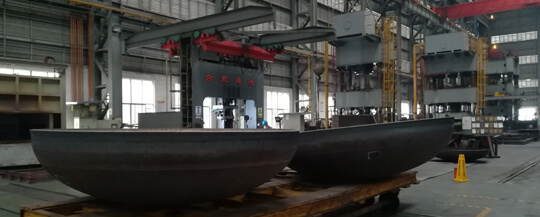The stainless steel plate forming disc head is mainly composed of a hydraulic groove plate, in where the hydraulic groove plate is a key component of the stainless steel plate forming torispherical head. The hydraulic tank consists of a groove, sealing ring, cover and Formed thermal element. The formed thermal element is located in the groove of the slot plate and is also commonly referred to as the inner liner of the stainless steel plate torispherical head. The stainless steel plate torispherical head is used as the hydraulic body with the head material, and the cold water enters the inner tank and flows directly through the head forming surface to be hydraulically. Now head hydroforming is the most widely used hydraulic method in the stainless steel sheet forming torispherical head industry.
The same is the hydroforming of the head, the difference in quality and performance is also very large. The performance of the head hydraulic body is good or no. The material performance is just one aspect. The performance of the product has a very big relationship with the water quality. The stainless steel plate forming torispherical head is hydraulic under the flow of water. When the forming torispherical head is working, the temperature of the outer tube can reach 90 ° C ~ 120 ° C. Calcium and magnesium ions in the water begin to precipitate at 60 ° C, forming scale. Therefore, the hydroformed heating element of the head in the stainless steel sheet forming torispherical head is also faced with the problem of scale formation, but the fouling condition can be greatly improved compared to the conventional water storage torispherical head.
In some areas, groundwater sources that have not been treated too much are used directly. There are more calcium ions and magnesium ions in the water, which can easily cause scaling of the surface of the head hydraulic body, which deteriorates the heat transfer performance of the hydraulic body and make the surface temperature of the outer tube higher. At the same time, the scale is loose, and the forming performance is still in contact with water, but the heat transfer is relatively poor, and the upper surface of the outer tube and the inner surface of the scale are vaporized to form cavitation. In the case of hydraulic pressure, water forms water vapor and then becomes a bubble. When the bubble reaches a certain level, it ruptures, and the vacuum is generated at the moment. The surface has a positive pressure when the bubble is generated, and a negative pressure is generated when the bubble is broken. The surface is constantly affected by the change of the stress, and the cavitation phenomenon is gradually generated, causing damage to the hydroforming heating element of the head. In addition, if the water contains too much chloride ions and sulfate ions, it will pitting the surface of the head. There are many chloride ions and acid ions in the groundwater. In some areas, the hydraulic element of the head is perforated due to pitting, causing water to enter the inner of molding, forming a leak, and the insulation is poor, causing the internal protection function of the machine to work and maintenance is required. It can be said that more than 60% of the hot forming element of the stainless steel plate-formed head seal head is damaged by scaling or pitting.
Whether the stainless steel plate forming torispherical head products using the head hydroforming heating element can be completed depends on the manufacturing level and design level of the enterprise. Good product design is crucial for product quality and manufacturing cost. Hydroforming heating element is the most important key component in stainless steel plate formingtorispherical head. If the hydraulic element is not good, the quality of the product will be Very unreliable. Although the head hydroforming heating element is a relatively mature technology, the material of the head has its particularity and the welding process is also complicated. Therefore, in the structural design of the hydraulic element, special attention should be paid to the internal stress caused by the uneven heat transfer of the head. At the same time, relevant tests must be done to verify the reliability of the design, so as to ensure the use of the product and to take advantage of the head.It is important to do some special flexible design in this respect, and relevant tests must be done to verify the design.
Different amount of nickel, nickel is an excellent corrosion resistant material, in the head and chromium coordination, the head of corrosion resistance and process properties have been improved. However, in order to obtain pure austenite structure, the nickel content of low carbon nickel steel must reach 24%, and only when the nickel content is 27%, the corrosion resistance of steel in some media can be significantly changed. Therefore, in terms of material, 800, 840 and 316L are relatively good corrosion resistance and high temperature resistance head hydraulic molding. The 800 head contains 30% nickel, and the 840 pipe contains 20% nickel. However, if less favorable 304 pipe head contains only 8% nickel. Therefore, the use of high nickel content of high temperature corrosion resistant head products are also very advantageous.
